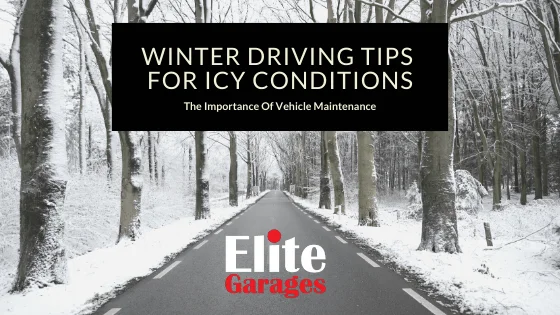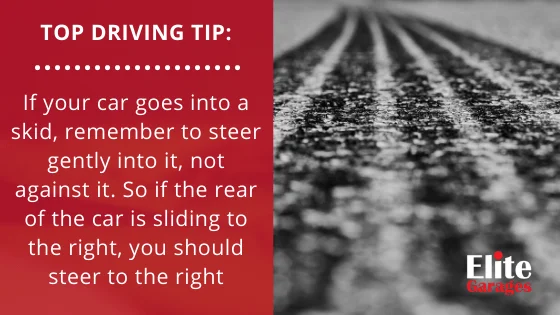
Winter Driving Tips For Icy Conditions
Winter Driving: How To Safely Handle Icy Conditions
Winter driving is often more dangerous than other seasons especially if you consider heavy rains and icy conditions. Sub-zero temperatures can lead to potentially hazardous road conditions with ice and snow being the two main culprits.
While winter driving conditions aren’t ideal, keeping up with regular car maintenance and following tyre safety tips, can reduce the risks. That said, driving habits also play a major part and you need to plan and prepare adequately. Fortunately, Elite Garages have the expert advice you need for driving safely in icy conditions.
Winter Driving Advice
Breakdowns often occur more frequently in winter which means regular car maintenance and vigilance on the road are essential. Adapting your driving style to the weather conditions will help ensure the safety of you, your passengers and other road users. Regardless of how well you think you can drive, anything can happen and you need to be prepared.
How Do I Prepare For Driving In Icy Conditions?
- Plan your journey ahead of time
- In icy conditions, tyre grip is heavily reduced which means braking distances are much longer
- Even if you don’t have an accident, your car may get stuck so pack a winter emergency kit
- Before you leave home, make sure your mobile phone is charged and that you pack a charger, an extra bottle of water, a few snacks and a warm blanket
- Traffic congestion is always worse in winter so be patient and don’t do anything silly
- If you’re meeting someone, inform them of the route you will take and when they can expect you
- Make sure that your windows and mirrors are completely clear before you set off
- In cars with different driving modes, choose the best option for cold and icy conditions
How Should I Drive On Icy Roads?
Allow extra time for winter journeys as traffic is almost always worse. You should also take it slow as, according to the AA, stopping distances are 10 times longer. Here are a few essential tips you should keep in mind at all times:
- Anticipation and gentle manoeuvres are vital in icy conditions
- Keep your speed down and look ahead for any potential hazards including patches of ice
- Reduce the risk of a skid by accelerating, braking, steering and changing gears as smoothly as possible
- Use a higher gear as it helps manage engine power delivery for better traction on packed ice
- In a manual car, you may have to slip the clutch a little to prevent the car from stalling
- Many automatic cars will allow you to select second gear at a standstill to pull away
Should I Fit Winter Tyres?
This question has been a hotly-debated topic for some time as it all comes down to how much time you spend driving in winter conditions. If you frequently drive for business, you should invest in a separate set of winter tyres. They’re well worth it as you can simply swap them every October and March for ultimate road safety.
Thanks to the deeper tread grooves on winter tyres, they disperse snow better than other tyres which result in exceptional grip in these types of conditions. Research studies have indicated that winter tyres outperform summer tyres whenever the temperature is below 7 degrees. This means that cars fitted with winter tyres should stop faster and are much less likely to skid.
Recommended: ‘Should I Buy Winter Tyres?’
Winter Driving And Black Ice
Black ice is a thin layer of ice that appears on the road surface in extreme weather conditions. Because of its smooth and transparent appearance, it looks just like the road surface making it almost invisible to drivers. This, of course, means black ice is one of the most dangerous elements drivers can face.
As a precaution, if the temperatures are low and the road surface looks wet, drive carefully as it could be black ice. You can identify black ice as follows:
- It sometimes appears as a glossy sheen on the road
- You could see it glinting in the sunlight
- Look ahead and spot other cars swerving for no obvious reason
- Keep a close eye on shaded roads, bridges, flyovers and tunnels as the surface temperature may be lower
How To Manage Black Ice And Skidding
If you do hit a patch of black ice, the first thing you should do is not panic. Always keep your hands on the steering wheel and keep it straight. Maintain your current speed so don’t accelerate or hit the brakes. Use the gears to slow down if needed and don’t make any sudden movements that could destabilise the car.

Tyre Safety And Winter Driving
When tyres are five years or older, you should get a tyre expert to inspect them at least once a year. According to Michelin, tyres older than 10 years after their date of manufacture should be replaced as a precaution. This applies to tyres that appear usable and not worn down to the tread wear indicator.
One of the most important tyre checks, especially in winter, is the tread depth. When fitting new tyres, the tread is a full 8 mm but this will wear down over time. While the minimum legal tread depth is 1.6 mm, it’s best to change your tyres when they reach 3 mm as it maximises the grip and handling of your car. Visit any of our Elite Garages to book a FREE tyre safety check for added peace of mind.
Related: ‘6 Things To Know About Your Tyre Tread’
Driving Recommendations In Icy Conditions
Visibility is of the utmost importance so make sure all the lights are working and that the lenses are clean. If the weather and roads are really bad, you may need to clean your lights after every trip. Remember to keep the windscreen and other windows clear of dirt, snow and stickers.
You should replace worn or damaged windscreen wipers as soon as possible and don’t leave them on auto when you park if there’s a risk of frost. If you use fog lights, switch them off when visibility improves so they don’t affect other drivers or hide your brake lights.
Contrary to popular belief, letting the air out of your tyres to get more grip doesn’t work. Lastly, you should consider getting winter tyres or all-season tyres as they are made from a special rubber for improved grip in cold and wet conditions.
Winter Driving And Safety Checks At Elite Garages
At Elite Garages, we offer drivers a comprehensive safety check which can help identify any underlying issues. In many cases, these checks find minor issues that could cause real concerns at a later stage. They help minimise your risk of breaking down in winter and avoid potentially fatal situations on the road. Book you FREE Winter Safety Check today!
Elite Garages is a family-owned business providing dealership quality services without the added costs or small print. We specialise in servicing vehicles of all makes and models, MOTs, quality tyres, shocks, brakes and vehicle safety checks to name a few.
Our technicians are friendly, professional and expertly trained to offer you the best possible advice and service. Contact any of our 13 branches across the UK and we will help you get back on the road in no time at all.
About Us
Opening Times
Saturday : 8:30–4:00
Sunday : closed
More Information
Contact UsCustomer Information Pack
Check MOT Due Date
Free MOT reminder
Careers
Legal Information
Recent Posts
- MOT in Dorchester: Keeping the South Coast Safely on the Move
- Car Battery Problems: Don’t Let a Dead Battery Flatten Your Day
- Bridgestone Tyres Promotion: Free Gift and Enter to Win £5,000
- Is Your Car Air Conditioning Ready for Autumn and Winter?
- Beyond Your Fareham MOT Centre: Tyres, Servicing, and Safety Checks


